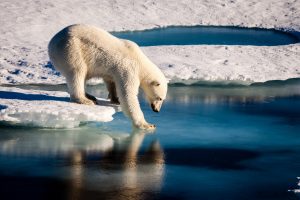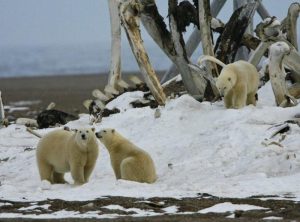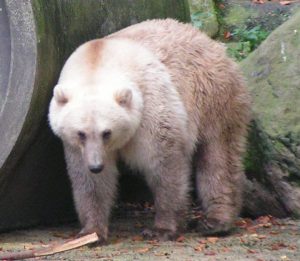Reference: Petherick, Ansley S., et al. “Dietary ecology of Alaskan polar bears (Ursus maritimus) through time and in response to Arctic climate change.” Global Change Biology (2021). DOI: https://doi.org/10.1111/gcb.15599

Puzzling Polar Bears
As the threat of climate change looms ever closer, scientists are noticing increasing changes in animals that live in the Arctic. As ice melts, animals who would normally use that ice for resting, eating, or travelling suddenly have to find new ways to survive. This seems to be especially true for polar bears. Historically these bears fed on Arctic ringed seals, who periodically emerge from the ocean onto pieces of ice, and whose blubber is incredibly nutritious. With less ice around, polar bears encounter this prey less often. In order to eat enough to stay alive, these bears have recently been seen eating in new areas, such as near grizzly bear territories on land, and consuming new food items, such as bone and edible pieces of human waste. These new food items are much harder to chew through compared to seal blubber, as one can imagine bone is a bit tougher to eat than fat.
Because of their changing diet, polar bears may be wearing down their teeth in new ways, which can hurt their dental health and prevent them from being able to eat in the future. Eating outside of their traditional food items could also be less nutritious, and lead to health issues. However, is there evidence that these new eating patterns are actually causing harm to polar bears? Are they actually eating enough of these new foods to cause any lasting damage? Researchers from Vanderbilt University in Tennessee conducted a study to find out.

Teeth Testing
Using a combination of polar bear teeth taken from museums and archaeological sites (ancient humans used parts of polar bears in clothing, weaponry, and decoration), researchers amassed data on polar bears stretching from 1000AD to 2009. They compared the teeth of these specimens to see if modern polar bears from the 21st century had noticeably different wear patterns on their teeth compared to older bears. It turned out that yes, the teeth of modern polar bears looked very different from that of polar bears from all other time periods, even those from the not-so-distant 20th century. Polar bears are eating much less fat, and much harder foods, than they have at any other point in over 1,000 years, and it is damaging their teeth. Considering that there have been other other instances of global warming and climactic change in the past 1,000 years, but these had little effects on polar bear diet or health, these results are very concerning.

What Does This Mean for Polar Bears?
As ice continues to melt in the Arctic, there will be less and less seals for polar bears to prey upon, leading to even more strange eating behaviors. Considering the data from this study stops at 2009, it is likely that trends are already worse than we know for these bears. Polar bears have been venturing closer to human settlements for food, and have crossed into grizzly bear territory so often that polar bear/grizzly bear hybrids (pizzlys, or grolar bears if you prefer) have been spotted. Polar bears are not adapted to these new foods and new habitats, and so populations will likely continue to decline as these bears struggle to survive. The entire species is projected to go extinct by the end of the century if nothing is changed. If climate change is not dealt with soon, it could be catastrophic for polar bears and the Arctic habitats they call home.
To find out ways you can help polar bears, you can visit the Polar Bears International website.
I received my PhD in Biology from Wake Forest University, and I received a BS in Biology from Cornell University. My research focuses on the terrestrial locomotion of fishes. I am particularly interested in how different fishes move differently on land, and how one fish may move differently in different environments. While I tend to study small amphibious fishes, I’ve had a lifelong fascination with all ocean animals, and sharks in particular. When not doing science, I enjoy running, attempting to bake and cook, and reading.


